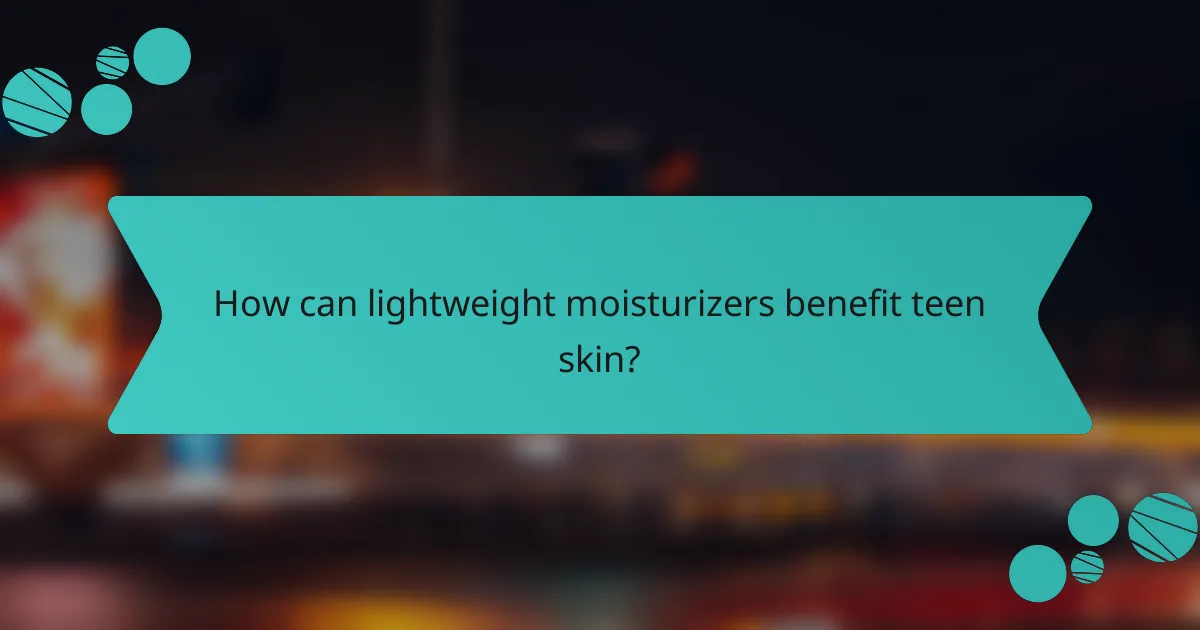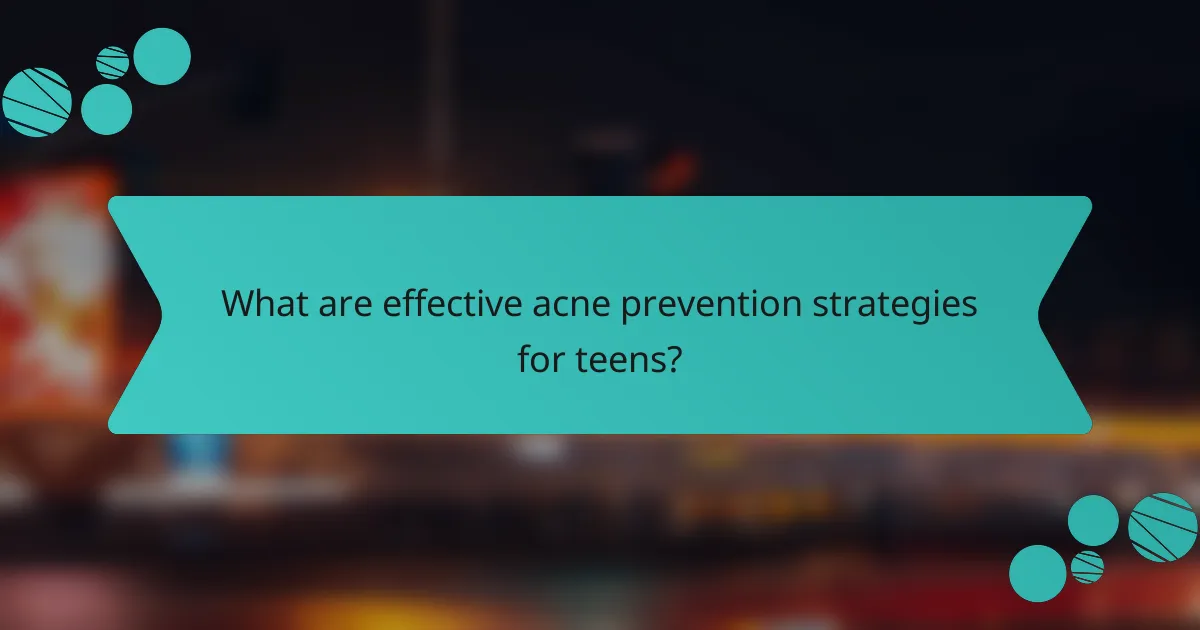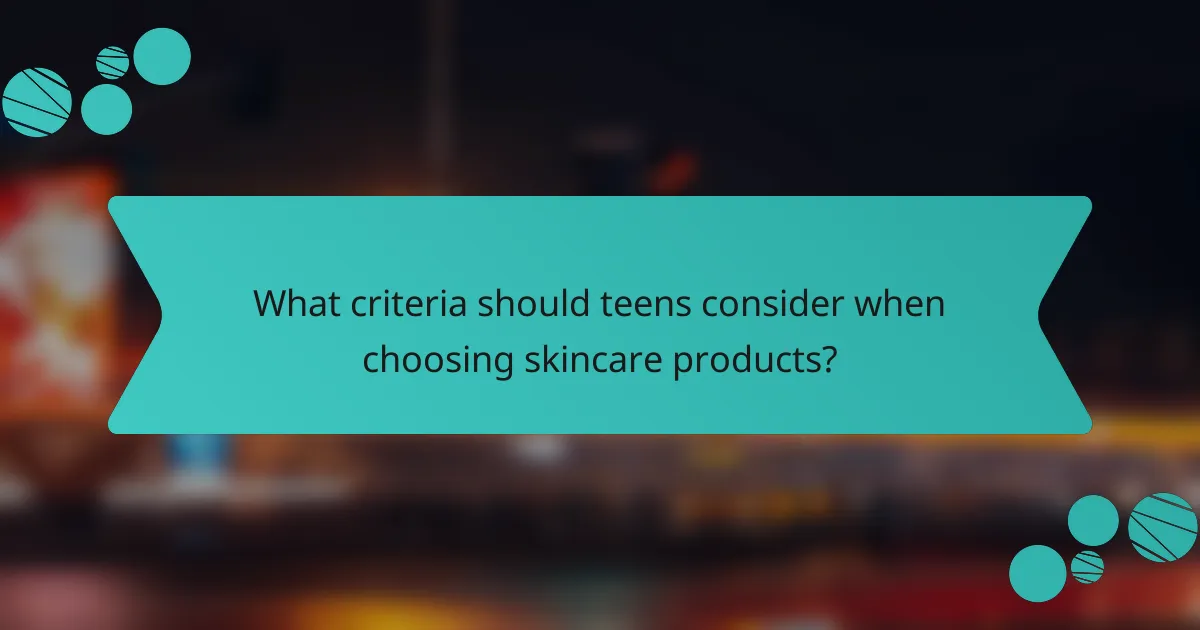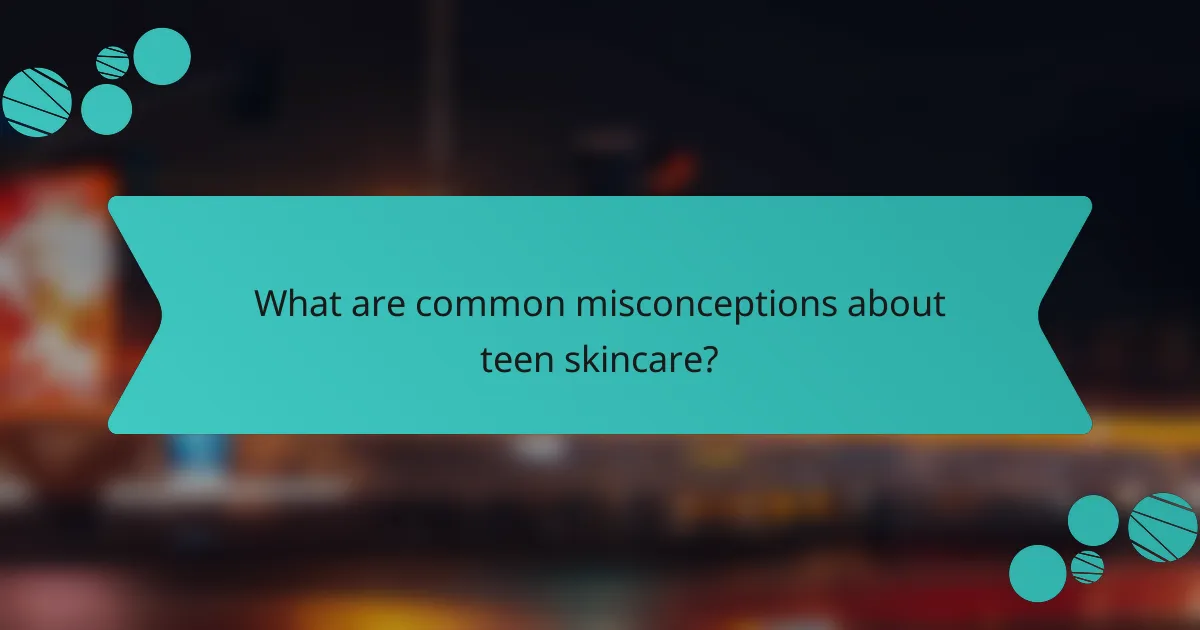Establishing a basic skin regimen is crucial for teens to maintain clear and healthy skin. This involves gentle cleansing twice daily to remove impurities while preserving natural moisture, along with lightweight moisturizers that hydrate without clogging pores. Additionally, incorporating effective acne prevention strategies can help reduce breakouts and promote a balanced complexion.

What is a basic teen skin cleansing routine?
A basic teen skin cleansing routine involves using gentle products to remove dirt, oil, and impurities without stripping the skin’s natural moisture. This routine typically includes cleansing twice daily to maintain clear skin and prevent acne.
Gentle foaming cleansers
Gentle foaming cleansers are ideal for teens as they effectively remove excess oil and impurities while being mild on the skin. Look for products that are sulfate-free and formulated for sensitive skin to avoid irritation.
Examples of gentle foaming cleansers include those containing ingredients like aloe vera or chamomile, which soothe the skin. Brands like Cetaphil and Neutrogena offer options that are widely recommended for young skin.
Micellar water options
Micellar water is a versatile cleansing option that can be used to remove makeup and cleanse the skin without rinsing. It contains tiny micelles that attract dirt and oil, making it effective yet gentle.
For teens, micellar water can be a quick solution for cleansing on-the-go. Look for alcohol-free formulas to prevent dryness, and consider brands like Bioderma or Garnier for reliable choices.
Frequency of cleansing
Teens should aim to cleanse their skin twice daily—once in the morning and once before bed. This helps to remove sweat, oil, and impurities accumulated throughout the day.
On particularly active days or after sports, an additional cleanse may be beneficial to prevent breakouts. However, over-cleansing can lead to dryness and irritation, so sticking to a twice-daily routine is usually best.
Best practices for application
When applying cleanser, use lukewarm water to wet the face, then gently massage the cleanser in circular motions for about 30 seconds. Rinse thoroughly to ensure no residue remains.
Always pat the skin dry with a clean towel instead of rubbing, as this minimizes irritation. Following up with a lightweight moisturizer can help maintain hydration after cleansing.

How can lightweight moisturizers benefit teen skin?
Lightweight moisturizers are essential for teen skin as they provide hydration without clogging pores. These products help maintain skin balance, reduce oiliness, and prevent acne breakouts, making them ideal for young skin that is often prone to excess oil and blemishes.
Oil-free gel moisturizers
Oil-free gel moisturizers are particularly beneficial for teens with oily or acne-prone skin. They are formulated with water-based ingredients that hydrate without adding extra oil, which can lead to breakouts. Look for gel moisturizers that feel light on the skin and absorb quickly for the best results.
When choosing an oil-free gel moisturizer, check for non-comedogenic labels to ensure they won’t clog pores. Products with a refreshing texture can also provide a cooling effect, which is especially nice in warmer climates.
Hydrating ingredients to look for
When selecting a lightweight moisturizer, look for hydrating ingredients like hyaluronic acid, glycerin, and aloe vera. Hyaluronic acid is known for its ability to hold moisture, making it a great choice for maintaining skin hydration without heaviness.
Additionally, ingredients like niacinamide can help with oil control and skin texture, while aloe vera offers soothing properties. Avoid products with heavy oils or fragrances that can irritate sensitive skin.
Recommended brands for teens
Several brands cater specifically to teen skin needs, offering lightweight moisturizers that are effective and affordable. Brands like Neutrogena, Cetaphil, and La Roche-Posay provide options that are well-reviewed for their non-comedogenic formulas.
Consider trying products like Neutrogena Hydro Boost Water Gel or Cetaphil PRO Oil Absorbing Moisturizer. These options are often available at drugstores and online, making them accessible for most budgets.

What are effective acne prevention strategies for teens?
Effective acne prevention strategies for teens include using targeted treatments, choosing the right products, and establishing consistent daily skincare habits. By focusing on these areas, teens can significantly reduce the occurrence of breakouts and maintain healthier skin.
Salicylic acid treatments
Salicylic acid is a popular ingredient in acne treatments due to its ability to penetrate pores and exfoliate dead skin cells. This helps to prevent clogged pores, which are a primary cause of acne. Look for over-the-counter products containing 0.5% to 2% salicylic acid for effective results.
When using salicylic acid, start with a lower concentration to assess skin tolerance, applying it once daily and gradually increasing usage if needed. Be mindful of potential dryness and irritation, and consider pairing it with a gentle moisturizer to maintain skin hydration.
Non-comedogenic products
Non-comedogenic products are formulated to avoid clogging pores, making them ideal for acne-prone skin. When selecting skincare and makeup items, look for labels that specifically state “non-comedogenic.” This can help minimize the risk of breakouts.
Common non-comedogenic ingredients include water-based moisturizers and lightweight sunscreens. Avoid heavy oils and thick creams that can exacerbate acne. Always check ingredient lists and opt for products designed for sensitive or acne-prone skin.
Daily skincare habits
Establishing daily skincare habits is crucial for preventing acne. A basic regimen should include cleansing, moisturizing, and sun protection. Use a gentle cleanser twice daily to remove dirt and excess oil without stripping the skin.
In addition to cleansing, apply a lightweight, non-comedogenic moisturizer to keep skin hydrated. Sunscreen is essential; choose a broad-spectrum SPF of at least 30 to protect against UV damage. Consistency is key, so stick to your routine even on busy days.

What criteria should teens consider when choosing skincare products?
Teens should focus on their skin type, ingredient safety, and potential allergies when selecting skincare products. Understanding these criteria helps in choosing effective and safe options for maintaining healthy skin.
Skin type identification
Identifying your skin type is crucial for selecting appropriate skincare products. Common skin types include oily, dry, combination, and sensitive. For instance, oily skin may benefit from gel-based cleansers and lightweight moisturizers, while dry skin often requires creamier formulations.
A simple way to determine your skin type is to observe how your skin feels after cleansing. If it feels tight and dry, you likely have dry skin. If it appears shiny shortly after washing, you may have oily skin.
Ingredient awareness
Being aware of ingredients is essential for effective skincare. Look for non-comedogenic products, which are less likely to clog pores, especially for acne-prone skin. Ingredients like salicylic acid and benzoyl peroxide can help prevent breakouts.
Additionally, consider opting for lightweight moisturizers that contain hydrating ingredients like hyaluronic acid or glycerin. Avoid heavy oils and fragrances that can irritate the skin or trigger acne.
Allergy considerations
Allergy considerations are vital when choosing skincare products, as some ingredients can cause reactions. Always check for common allergens like fragrances, parabens, and sulfates, especially if you have sensitive skin.
Before trying a new product, perform a patch test on a small area of skin to see how your body reacts. If irritation occurs, discontinue use immediately and consult a dermatologist for alternatives that suit your skin’s needs.

What are common misconceptions about teen skincare?
Many teens believe that skincare is only about using harsh products to combat oiliness and acne. In reality, a balanced regimen focusing on gentle cleansing, lightweight moisturizers, and understanding skin types is essential for healthy skin.
Myths about oily skin
A common myth is that oily skin does not need moisturizing. In fact, even oily skin requires hydration to maintain balance and prevent overproduction of oil. Using a lightweight, non-comedogenic moisturizer can help keep skin hydrated without clogging pores.
Another misconception is that oily skin is solely caused by poor hygiene. While dirt and excess oil can contribute to skin issues, factors like genetics, hormones, and diet also play significant roles. It’s crucial to adopt a holistic approach to skincare that considers these elements.
Understanding acne triggers
Acne can be triggered by various factors, including hormonal changes, stress, and certain foods. For teens, hormonal fluctuations during puberty often lead to increased oil production, which can clog pores and result in breakouts.
Additionally, some ingredients in skincare and makeup products can exacerbate acne. It’s advisable to look for products labeled as “non-comedogenic” and to avoid heavy formulations that can lead to clogged pores. Keeping a consistent cleansing routine can help mitigate these triggers.
